Broad Street, Oxford
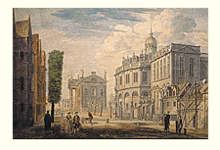
Broad Street is a wide street in central Oxford, England, located just north of the old city wall.[1][2][3] The street is known for its bookshops, including the original Blackwell's bookshop at number 50, located here due to the University. Locally, the street is traditionally known as The Broad.
Location

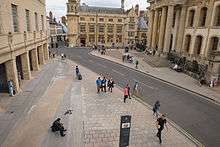
Located in Broad Street are Balliol College, Trinity College, Exeter College (front entrance in the adjoining Turl Street).[2][3] The Museum of the History of Science (the original location of the Ashmolean Museum), the Clarendon Building, the Sheldonian Theatre and the new Weston Library building (renamed in 2015, part of the Bodleian Library, the main University library in Oxford) are important historical Oxford University buildings at the eastern end of the street. The question is often asked "Where is the University?". These buildings form the nearest equivalent to the centre of the University, since most academic buildings in the centre of Oxford are owned by individual (and autonomous) colleges rather than the University itself.
To the west, the street continues as George Street, with Magdalen Street to the north and Cornmarket Street to the south. To the east, the street continues as Holywell Street, with Parks Road to the north and Catte Street to the south. The King's Arms, a popular public house frequented by Oxford University students, is on the north-east corner of the junction and the Indian Institute (now The James Martin 21st Century School), designed by Basil Champneys, is on the south-east corner.
History
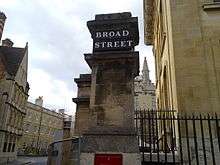
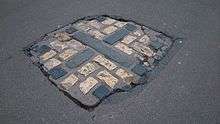
The first city wall was built south of the street in 911.[4]
The street was the site where the Protestant Oxford Martyrs, Hugh Latimer and Nicholas Ridley (16 October 1555), and later Thomas Cranmer (21 March 1556), were burnt at the stake just outside the then northern city walls.[4] A cobbled cross in the road opposite Balliol College marks the location. Not far away in St Giles', the events are commemorated with a Victorian stone monument, the Martyrs' Memorial.
The Sheldonian Theatre, set back from Broad Street behind a stone wall and railings with impressive stones heads (traditionally Roman emperors), was built 1664–1668 from a design by Sir Christopher Wren for the University of Oxford. The Old Ashmolean Building was built in 1683 to house Elias Ashmole's collection. It was the world's first museum to open to the public. The Clarendon Building was built 1711–1715 to house the Oxford University Press's printing operations. It was designed by Nicholas Hawksmoor, considered Christopher Wren's best pupil.
The academic and physician Henry Acland lived in the street at number 40 on the site of the new Weston Library, part of Oxford University's Bodleian Library. His daughter, Sarah Angelina Acland, the colour photography pioneer, was born here.[5]
Shops
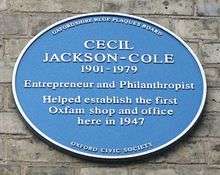
Boswells, now the largest independent department store in Oxford, was established in 1738, and has been trading in the same spot on the south side of Broad Street opposite Balliol College ever since. Thornton's Bookshop, also on the south side of the street at No. 11, was founded by Joseph Thornton (1808–1891) in 1835, but closed its shop at the end of 2002.
The Victorian photographer Henry Taunt had a shop and studio at 9–10 Broad Street, moving here from Cornmarket Street in 1874. He also established a picture-framing business in Boxall's Yard, behind the premises. The lease expired in 1894 and he was forced to file for bankruptcy.
Blackwell's bookshop, on the north side of the street, was founded by Benjamin Henry Blackwell, the son of the first city librarian, in 1879. The shop was initially only twelve feet square, but quickly grew to include space upstairs, in the cellar, and neighbouring shops. It is now Oxford's most famous and leading bookshop, with other specialist branches elsewhere in Broad Street and Oxford.
The first Oxfam charity shop together with its office were established by Cecil Jackson-Cole (1901–1979) at 17 Broad Street in 1947. There is still an Oxfam shop here and a blue plaque has been placed on the outside wall of the building.[6]
References
- ↑ Broad Street, Oxford History, UK.
- 1 2 Sherwood, Jennifer; Pevsner, Nikolaus (1974). The Buildings of England: Oxfordshire. Penguin Books. pp. 71, 100, 134, 137, 138, 203, 254, 263, 312, 313. ISBN 0-14-071045-0.
- 1 2 Tyack, Geoffrey (1998). Oxford: An architectural guide. Oxford University Press. pp. 22, 35, 51, 54, 116, 117, 119, 126, 128, 151, 182, 210, 223, 228, 253, 256, 263, 292, 325. ISBN 0-14-071045-0.
- 1 2 "Landmarks in the History of Broad Street". Broad Street, Oxford. Oxford History, UK. Retrieved August 3, 2012.
- ↑ Hudson, Giles (2012). "Chronology". Sarah Angelina Acland: First Lady of Colour Photography. Oxford: Bodleian Library, University of Oxford. p. 7. ISBN 978 1 85124 372 3.
- ↑ Cecil Jackson-Cole (1901–1979) Archived December 11, 2009, at the Wayback Machine., Oxfordshire Blue Plaques Scheme, UK.
External links
-
 Media related to Broad Street, Oxford at Wikimedia Commons
Media related to Broad Street, Oxford at Wikimedia Commons
Coordinates: 51°45′16″N 1°15′24″W / 51.75444°N 1.25667°W